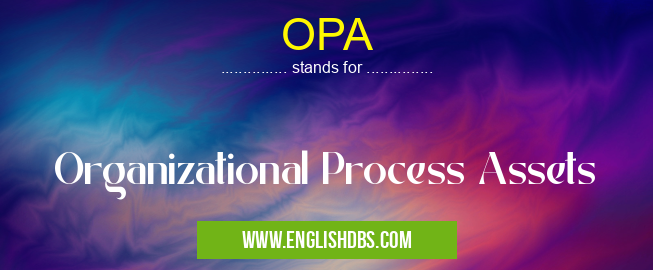What does OPA mean in UNCLASSIFIED
Organizational Process Assets (OPA) refer to a collection of vital documentation, knowledge, and information that are essential for an organization's efficient functioning. These assets encompass industry-specific best practices, methodologies, templates, policies, and procedures that guide the organization's operations.

OPA meaning in Unclassified in Miscellaneous
OPA mostly used in an acronym Unclassified in Category Miscellaneous that means Organizational Process Assets
Shorthand: OPA,
Full Form: Organizational Process Assets
For more information of "Organizational Process Assets", see the section below.
Types of OPAs
OPAs can be categorized into various types, including:
- Knowledge and Expertise: This includes technical knowledge, industry insights, and specialized know-how acquired through experience and training.
- Documents and Records: These are formal documents such as policies, procedures, manuals, and plans that provide detailed instructions and guidelines for specific tasks and processes.
- Tools and Templates: This category includes templates, forms, checklists, and software tools that facilitate the execution of processes and tasks.
- Data and Information: This refers to structured data and information related to the organization's operations, such as customer profiles, financial reports, and performance metrics.
Benefits of OPAs
OPAs offer numerous benefits for organizations, including:
- Improved Efficiency and Productivity: Standardized processes and guidelines reduce confusion and errors, leading to increased efficiency and productivity.
- Enhanced Consistency and Quality: Documented procedures ensure that tasks are performed consistently and meet quality standards.
- Reduced Risks and Compliance: Clear policies and guidelines help organizations mitigate risks and ensure compliance with regulations and industry standards.
- Knowledge Preservation and Transfer: OPAs capture and preserve valuable knowledge that can be transferred to new employees and successors.
- Facilitated Continuous Improvement: By documenting and analyzing OPAs, organizations can identify areas for improvement and optimize their processes over time.
Essential Questions and Answers on Organizational Process Assets in "MISCELLANEOUS»UNFILED"
What are Organizational Process Assets (OPAs)?
Organizational Process Assets (OPAs) are reusable plans, policies, procedures, templates, and other documents that support the organization's processes. They help organizations maintain consistency, improve efficiency, and reduce risks.
What types of OPA are there?
Common types of OPA include:
- Process descriptions
- Policies and procedures
- Guidelines and templates
- Work instructions
- Checklists
- Process maps
- Performance metrics
- Lessons learned
What are the benefits of using OPAs?
OPAs offer numerous benefits, such as:
- Improved consistency and standardization
- Increased efficiency and productivity
- Reduced risks and errors
- Enhanced knowledge sharing
- Facilitated training and onboarding
How can OPAs be used to improve processes?
OPAs can be leveraged to:
- Identify and document existing processes
- Analyze and evaluate process performance
- Design and implement process improvements
- Monitor and control processes
- Provide guidance and support to process stakeholders
How are OPAs managed and maintained?
OPA management typically involves:
- Establishing a central repository for OPAs
- Version control and change management
- Regular review and update of OPAs
- Training and communication to ensure users are aware of and using the latest versions
Final Words: Organizational Process Assets (OPA) are invaluable resources that enable organizations to operate effectively and efficiently. By leveraging OPAs, organizations can improve their performance, reduce risks, and facilitate continuous improvement. The effective management of OPAs is essential for businesses seeking to achieve sustained success and competitiveness.
OPA also stands for: |
|
| All stands for OPA |
